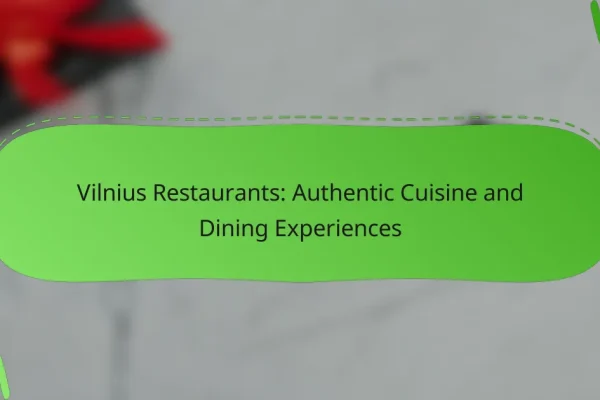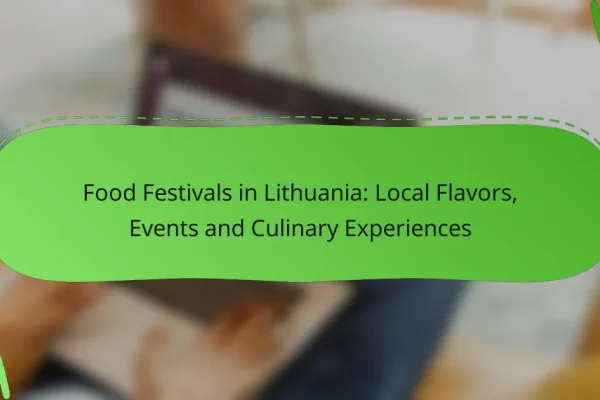What are the must-try dishes in Lithuanian cuisine?
Lithuanian cuisine features a variety of hearty and flavorful dishes that reflect the country’s agricultural roots. Must-try dishes include Cepelinai, Šaltibarščiai, Kugelis, Šakotis, and Vedarai, each offering a unique taste of Lithuania’s culinary heritage.
Cepelinai (Zeppelins)
Cepelinai, or Zeppelins, are large potato dumplings typically filled with minced meat, curd, or mushrooms. They are named for their resemblance to zeppelins and are often served with a creamy sauce made from sour cream and bacon. This dish is a staple in Lithuanian households and is especially popular during festive occasions.
When preparing Cepelinai, it’s essential to use starchy potatoes for the best texture. The cooking process involves boiling the dumplings until they float, indicating they are cooked through. Pair them with a side of pickled vegetables for a balanced meal.
Šaltibarščiai (Cold Beet Soup)
Šaltibarščiai is a vibrant cold beet soup that is refreshing and perfect for summer. Made with beets, cucumbers, dill, and buttermilk or kefir, this dish is not only visually appealing but also nutritious. It is typically served chilled, often with a side of boiled potatoes.
This soup is easy to prepare and can be made in advance, allowing the flavors to meld. Adjust the thickness by varying the amount of buttermilk, and consider adding hard-boiled eggs for extra protein and texture.
Kugelis (Potato Pudding)
Kugelis is a savory potato pudding that combines grated potatoes, eggs, and bacon, baked until golden brown. This dish is hearty and often served as a side or main course, showcasing the versatility of potatoes in Lithuanian cooking. It is commonly enjoyed with sour cream or applesauce.
For the best results, use a mix of waxy and starchy potatoes to achieve a balanced texture. Baking Kugelis in a cast-iron skillet can enhance its crispy edges, making it even more delicious.
Šakotis (Tree Cake)
Šakotis, or Tree Cake, is a traditional Lithuanian dessert known for its unique shape and texture. Made from a batter of eggs, sugar, and flour, it is baked on a rotating spit, resulting in a distinctive tree-like appearance. This cake is often enjoyed during celebrations and special occasions.
To achieve the characteristic layers, the batter is applied in small amounts, allowing each layer to cook before adding more. This requires patience and skill, but the result is a visually stunning cake that is sure to impress.
Vedarai (Stuffed Sausages)
Vedarai are traditional Lithuanian stuffed sausages made from potato dough and filled with meat, often served with sour cream or mustard. This dish reflects the country’s love for hearty, filling meals and is commonly prepared for family gatherings and celebrations. The combination of flavors makes Vedarai a comforting dish.
When making Vedarai, ensure the filling is well-seasoned to enhance the overall taste. Cooking them in a broth can add additional flavor and moisture, making them even more enjoyable.
Where to find authentic Lithuanian restaurants?
To experience authentic Lithuanian cuisine, seek out local restaurants that emphasize traditional dishes and ingredients. Look for establishments that are well-reviewed by locals or have been recommended by culinary guides.
Vilnius dining options
Vilnius, the capital city, offers a variety of dining options that showcase Lithuanian flavors. Restaurants like “Senoji Trobelė” and “Etno Dvaras” serve classic dishes such as cepelinai (potato dumplings) and šaltibarščiai (cold beet soup).
When dining in Vilnius, consider visiting during lunch hours for special deals, as many places offer set menus at reduced prices. Reservations are recommended on weekends, especially at popular spots.
Klaipėda local favorites
Klaipėda, a port city, features seafood prominently in its culinary scene. Restaurants like “Momo Grill” and “Fried Fish” focus on fresh catches from the Baltic Sea, offering dishes like smoked fish and fish soup.
In Klaipėda, don’t miss the chance to try local specialties like šaltibarščiai, which is particularly refreshing during the summer months. Many eateries also provide outdoor seating with views of the harbor.
Kaunas culinary spots
Kaunas boasts a vibrant food scene with a mix of traditional and modern Lithuanian cuisine. Restaurants such as “Naf Naf” and “Višta Puode” are popular for their hearty portions and authentic flavors, featuring dishes like kugelis (potato pudding) and various meat stews.
In Kaunas, look for food festivals or markets that highlight local produce and artisanal products. These events often provide a great opportunity to sample a variety of dishes and discover new favorites.
How to prepare traditional Lithuanian dishes?
Preparing traditional Lithuanian dishes involves using fresh, local ingredients and following specific recipes that highlight the country’s culinary heritage. Key dishes like Cepelinai, Šaltibarščiai, and Kugelis each have unique preparation methods that reflect Lithuanian culture and flavors.
Step-by-step Cepelinai recipe
To make Cepelinai, start by boiling potatoes and mashing them until smooth. Combine the mashed potatoes with grated raw potatoes, forming a dough-like consistency. Fill this dough with a mixture of ground meat, onions, and spices, then shape it into oval dumplings.
Cook the dumplings in salted boiling water for about 30-40 minutes until they float to the surface. Serve them with a creamy sauce made from sour cream, bacon, and onions for an authentic taste.
Making Šaltibarščiai at home
Šaltibarščiai is a cold beet soup that is refreshing and vibrant. Begin by boiling beets until tender, then peel and grate them. Combine the grated beets with buttermilk or kefir, diced cucumbers, green onions, and dill for flavor.
Let the soup chill in the refrigerator for at least an hour before serving. This dish is typically enjoyed with boiled potatoes on the side, making it a perfect summer meal.
Kugelis preparation guide
Kugelis is a traditional potato pudding that requires minimal ingredients. Start by grating potatoes and mixing them with eggs, milk, and bacon. Season with salt and pepper to taste.
Pour the mixture into a greased baking dish and bake at a moderate temperature for about an hour until the top is golden brown. Serve Kugelis hot, often accompanied by sour cream or applesauce for added flavor.
What are the key ingredients in Lithuanian cooking?
The key ingredients in Lithuanian cooking include potatoes, rye, and various dairy products. These staples form the foundation of many traditional dishes, reflecting the country’s agricultural heritage and local climate.
Potatoes as a staple
Potatoes are a fundamental component of Lithuanian cuisine, often featured in a variety of forms such as boiled, mashed, or fried. They are used in popular dishes like cepelinai, which are potato dumplings filled with meat.
Given their versatility, potatoes can be paired with many other ingredients, making them a go-to choice for both everyday meals and festive occasions. Expect to find them in soups and salads as well.
Rye bread significance
Rye bread holds a special place in Lithuanian culture, often considered a symbol of hospitality. It is typically dense and dark, made from whole grain rye flour, and is a staple at nearly every meal.
This bread is not only nutritious but also complements a wide range of dishes, from hearty soups to cured meats. Many families still bake their own rye bread, preserving traditional recipes passed down through generations.
Dairy products in dishes
Dairy products are integral to Lithuanian cooking, with items like sour cream, cheese, and buttermilk commonly used. Sour cream is often served as a topping for various dishes, enhancing flavors and adding creaminess.
Cheese, particularly curd cheese, is frequently incorporated into pastries and desserts, showcasing the rich dairy farming tradition in the country. Local cheeses can vary widely in flavor and texture, making them a delightful addition to any meal.
How does Lithuanian cuisine reflect cultural heritage?
Lithuanian cuisine is a rich tapestry that showcases the country’s cultural heritage through its ingredients, cooking methods, and traditional dishes. Influenced by various historical events and neighboring cultures, it emphasizes seasonal produce and hearty flavors, often featuring potatoes, rye, and dairy products.
Historical influences on food
The historical influences on Lithuanian food are significant, stemming from periods of Polish-Lithuanian Commonwealth and interactions with Russian, German, and Jewish cuisines. These interactions introduced diverse cooking techniques and ingredients, creating a unique blend that characterizes modern Lithuanian dishes.
For example, the use of beets and cabbage can be traced back to these influences, while the popularity of rye bread reflects the agricultural practices of the region. Traditional methods such as smoking and pickling are also remnants of historical preservation techniques.
Festive dishes and traditions
Festive occasions in Lithuania are marked by specific dishes that highlight cultural traditions. For instance, during Christmas, families prepare a special meal known as Kūčios, which includes twelve dishes symbolizing the apostles, often featuring fish, beetroot soup, and various grain-based foods.
Another important celebration is Užgavėnės, a pre-Lenten festival where rich foods like pancakes and meat dishes are enjoyed, emphasizing the transition from winter to spring. These festive meals not only bring families together but also preserve and celebrate Lithuanian cultural identity through food.







